Overview:
The Gokyo Valley Trek is an incredible journey through the majestic Himalayas, offering stunning views of towering peaks, serene turquoise lakes, and vibrant Sherpa culture. This 14-day adventure starts in Kathmandu, where you’ll prepare for the trek and explore the city’s rich heritage.
You’ll then fly to Lukla and trek through picturesque villages to the tranquil Gokyo Valley. The trek combines challenging hikes with cultural experiences, making it a perfect choice for adventurers seeking beauty and tranquility in less crowded paths.
In addition, if you wish to explore Everest region in short days, then then you could join our Rapid Everest Base Camp Trek or Everest Base Camp Trek-16 Days which also offer an opportunity to enjoy its natural beauties, enhance cultural experiences. If you want to add day/s climbing experience while trekking in Gokyo Valley and EBC Trek, you may join our Island Peak.
If you are not satisfied with this itinerary or if you want to customize this package in your timeline or budget, then you could contact us, or email to info@hikingnepal.com
Itinerary Outline:
1st Day: Arrival day in Kathmandu (1,300m/4,264 ft)
2nd Day: Fly to Lukla (2,800m/9,186ft) & trek to Phakding (2,652m/8,700ft), a 3-4 hrs walk
3rd Day: Trek from Phakding to Namche Bazaar (3,440m/11,283ft), 5-6 hrs walk
4th Day: Acclimatization day at Namche Bazaar
5th Day: Trek to Dole (4200m/13,776ft), 5-6 hrs walk
6th Day: Trek to Machharmo (4470m/ 14,663ft), 4-5 hrs walk
7th Day: Trek to Gokyo (4800m/15,744ft), 3-4 hrs walk
8th Day: Acclimatization and exploration around Gokyo
9th Day: Trek from Gokyo to Phorse Village/ Phorste Thanga (3680 m), 5 to 6 hrs walk
10th Day: Trek from Phortse to Tyangboche (3,867m/12684ft), 5-6 hrs walk
11th Day: Trek from Tyangboche to Namche via Khumjung(3,790m/12,431ft), 6 – 7 hours walk
12th Day: Trek back to Lukla (2,800m/9,186ft), 4-5 hrs walk
13th Day: Fly back to Kathmandu (1,300m/4,264 ft)
14th Day: Departure from Kathmandu
End of our services
Day 1: Arrival day in Kathmandu (1,300m/4,264 ft)+
Welcome to Kathmandu! After arriving, you’ll transfer to your hotel. Spend the day exploring the bustling city, visiting historical sites like Swayambhunath (Monkey Temple) or Durbar Square, and preparing for your trek.
Day 2: Fly to Lukla (2,800m/9,186ft) & trek to Phakding (2,652m/8,700ft), a 3-4 hrs walk+
Your adventure begins with an early flight to Lukla, offering breathtaking views of the mountains. From Lukla, you’ll trek through charming villages and lush forests to Phakding. The 3-4 hour walk helps you acclimatize and enjoy the scenery.
Day 3: Trek from Phakding to Namche Bazaar (3,440m/11,283ft), 5-6 hrs walk+
Today’s trek to Namche Bazaar takes about 5-6 hours. You’ll cross suspension bridges over the Dudh Koshi River, passing through pine forests and small settlements. As you ascend, you might catch your first glimpse of Everest. Namche, the Sherpa capital, offers vibrant markets and stunning views.
Day 4: Acclimatization day at Namche Bazaar+
Spend a day acclimatizing in Namche Bazaar. Explore the bustling market, visit the Sherpa Culture Museum, or take a hike to the Everest View Hotel for panoramic views of Everest, Lhotse, and Ama Dablam. This day is crucial for adjusting to the altitude.
Day 5: Trek to Dole (4200m/13,776ft), 5-6 hrs walk+
The trail to Dole ascends steeply out of Namche, passing through beautiful rhododendron forests and small villages. After a 5-6 hour trek, you’ll reach Dole, a small settlement with stunning views of the surrounding peaks.
Day 6: Trek to Machharmo (4470m/ 14,663ft), 4-5 hrs walk+
A 4-5 hour trek takes you further up the valley to Machharmo. The trail offers breathtaking views of Cho Oyu and other peaks. Machharmo is also known for the first sighting of the Yeti in 1974, adding a touch of mystery to your journey.
Day 7: Trek to Gokyo (4800m/15,744ft), 3-4 hrs walk+
Today’s 3-4 hour trek brings you to Gokyo, home to the stunning Gokyo Lakes. The turquoise lakes, with the backdrop of Cho Oyu, create a picture-perfect setting. Take your time to enjoy the serenity and beauty of the area.
Day 8: Acclimatization and exploration around Gokyo+
Spend the day exploring the Gokyo area. You can hike to Gokyo Ri (5,357m/17,575ft) for an unparalleled view of Everest, Makalu, and Cho Oyu. Alternatively, explore the other Gokyo Lakes or relax and enjoy the tranquil environment.
Day 9: Trek from Gokyo to Phorse Village/ Phorste Thanga (3680 m), 5 to 6 hrs walk+
Descending from Gokyo, you’ll trek for about 5-6 hours to Phorse Village. The trail offers beautiful vistas and a chance to see diverse wildlife, including Himalayan pheasants and mountain goats. Phorse is a peaceful village with warm hospitality.
Day 10: Trek from Phortse to Tyangboche (3,867m/12684ft), 5-6 hrs walk+
Today’s 5-6 hour trek takes you to Tyangboche, famous for its monastery and panoramic views of Everest, Nuptse, and Ama Dablam. The Tyangboche Monastery is a spiritual center for the Sherpa people and a highlight of the trek.
Day 11: Trek from Tyangboche to Namche via Khumjung(3,790m/12,431ft), 6 - 7 hours walk+
A 6-7 hour trek leads you back to Namche Bazaar, passing through the village of Khumjung. Visit the Khumjung Monastery, known for its supposed Yeti scalp, and enjoy the stunning scenery along the way. This route provides more cultural insights and beautiful landscapes.
Day 12: : Trek back to Lukla (2,800m/9,186ft), 4-5 hrs walk+
Retrace your steps from Namche to Lukla over 4-5 hours. Enjoy your last evening in the mountains, reflecting on your journey and celebrating your accomplishments with your trekking companions.
Day 13: Fly back to Kathmandu (1,300m/4,264 ft)+
An early morning flight takes you back to Kathmandu. Once in the city, you can relax or explore more of Kathmandu’s cultural and historical sites, maybe visiting the Garden of Dreams or taking a stroll through Thamel.
Day 14: Departure from Kathmandu+
Your trek concludes today. Depending on your flight schedule, you may have time for some last-minute shopping or sightseeing before your departure. Have a safe journey home, and take with you unforgettable memories of the Himalayas.
Group Size:
For group, we normally run with minimum 2 person to maximum 10 in our published group departure program. However, there is no barrier for a private trip. We can run a trip for single person and even more than 10 in a group. Normally for a group, we provide 1 main guide, 1 assistance guide along with 1 porter for every 2 trekkers. Moreover, for every additional 2 trekkers, 1 more assistance and a porter will be provided making a team combination as follows:
Minimum to 2 PAX: 1 Guide and 1 porter
4-6 PAX: 1 guide, 1 assistance guide and 3 porter
7-10 PAX: 1 guide, 2 assistance guide and 4/5 Porter
Guide and Trip Safety
Once, you confirm your trip, it is our responsibility to make your trip wonderful without creating any difficulties. Hence, we have prepared our itinerary in such a way that it will properly acclimatize you. Also, we request you in advance to have regular exercises and make habits to walk in a daily basis. Similarly, during trek, you will be fully guided by our professional trekking guides and supporting team. They are properly trained in regards to safety and first aid. Even, we have every set up in case of emergency such as high altitude medicine and Gammow Bag (High altitude Chamber bag). Please note High altitude Chamber Bag is used to provide heat in your body and it is available on certain cost. Moreover, to let you familiar with altitude, you are suggested to walk slow and steady and ensure for proper acclimatization.
For trekking, we provide local experienced guide speaking fluent English and familiar with the local routes, landscape, flora, fauna as well as culture, and tradition of certain areas and let you feel comfortable. We do not encourage for child labor, hence, our porter will be above 16 years that are living in the Himalayas of Nepal; as well as carries only 20-22 kg weight per porter. Normally, the guide and support teams are selected with proper analyzing of their experience, leadership skills and personal aptitude. Our guides are well familiar with different societies of all caste and customs along the trail and share the insight culture with you that are not even noted in guide book.
To make our staffs more fluent and experienced, we consistently provide trainings. They have been participating in special training programs like Trekking guide training, Rock climbing, Ice climbing, Intensive Wilderness first Aid and many more that has been certified and approved by Nepal Government.
Travel Insurance
While travelling to Nepal, you are requested to have a travel insurance that should cover any comprehensive expenses possible to acquire due to medical issues or accidents. Especially, your travel insurance must protect air ambulance, treatment charges, rescue and evacuation, product cancellation and refundable charges, flight delay and cancellations. We suggest you to bring you travel insurance certificate or send us scan copy and required to issue from your home land and we do not arrange or sell insurance.
Travelling in the Himalayas is full of adventurous; hence it is wise to choose a proper insurance policy. While choosing your insurance policy, make sure that it will protect all such unforeseen expenses. Your insurer should be well familiar with our itinerary that you have booked and must have agreed to cover all activities being undertaken during trip. Meantime, it is not compulsory that our all the assigned trip are facilities with Heli-rescue. You will not require heli rescue insurance for Tibet Tour as it is not possible to provide such facility.
At the higher altitude, you will feel a decrease in availability of oxygen. If a person walk in the high altitude particularly climbs up too quickly, he might suffer from High altitude sickness. Hence, proper rest is required at that altitude. You can cure at right time knowing certain symptoms of Altitude Sickness. Common symptoms are headache, loss of appetite, tiredness and nausea, vomiting, dizziness and difficulty in sleeping. The best remedies that local belief and take is taking garlic, or ginger in mouth. Eat dry food and take liquid as much as possible. We recommend Diamox if there is no any options.
Also, we provide experienced guide and staffs in dealing with the effects of higher altitudes. As they are natives of Nepal, they easily acclimatize and therefore can care for their clients. They are equipped with necessary medical supplies and will assist with basic first aid treatment. We design our tours to ensure clients are ready for high altitude, and arrange alternative itineraries for those at risk.
| Start Date | Trip Price | Action |
|---|




